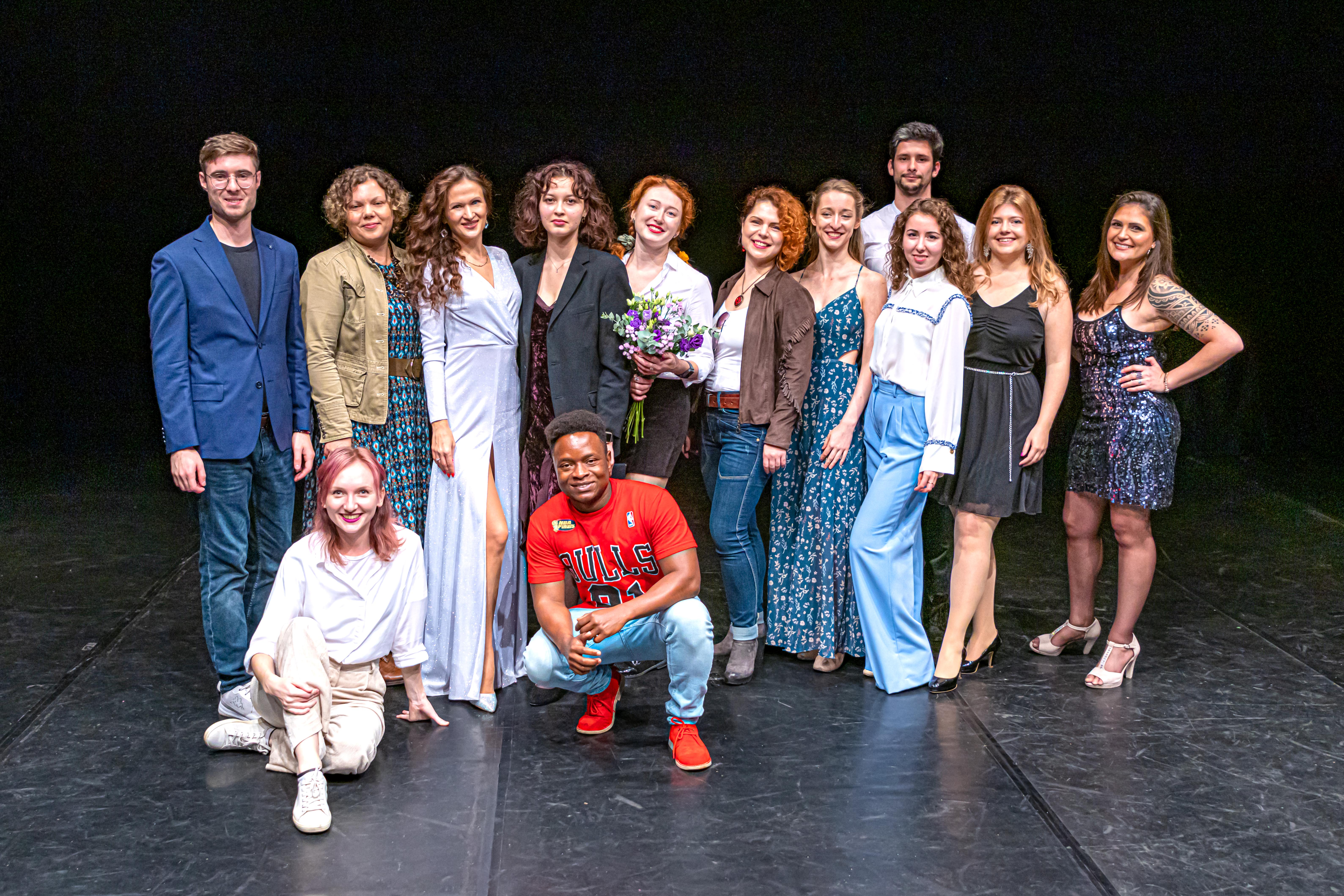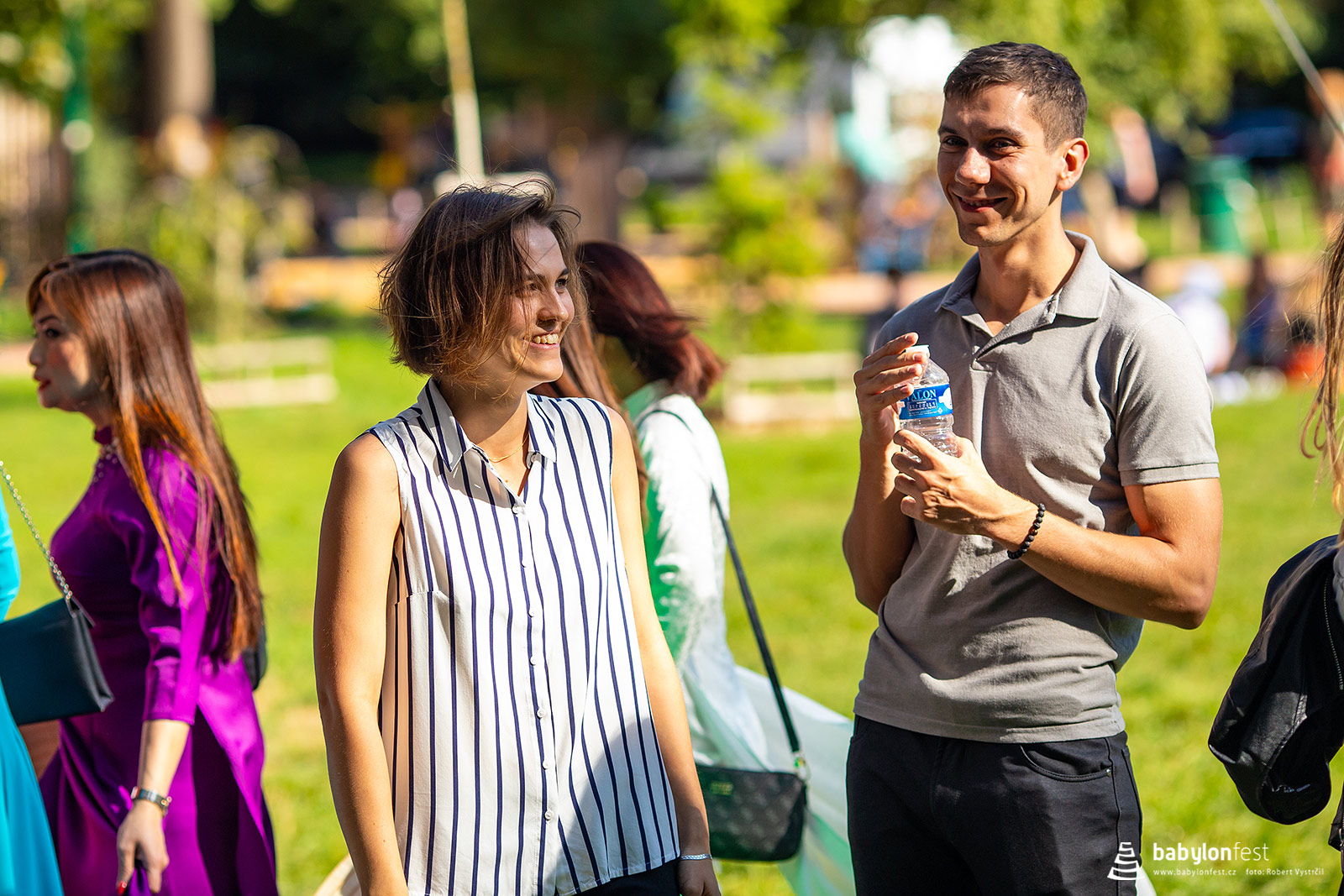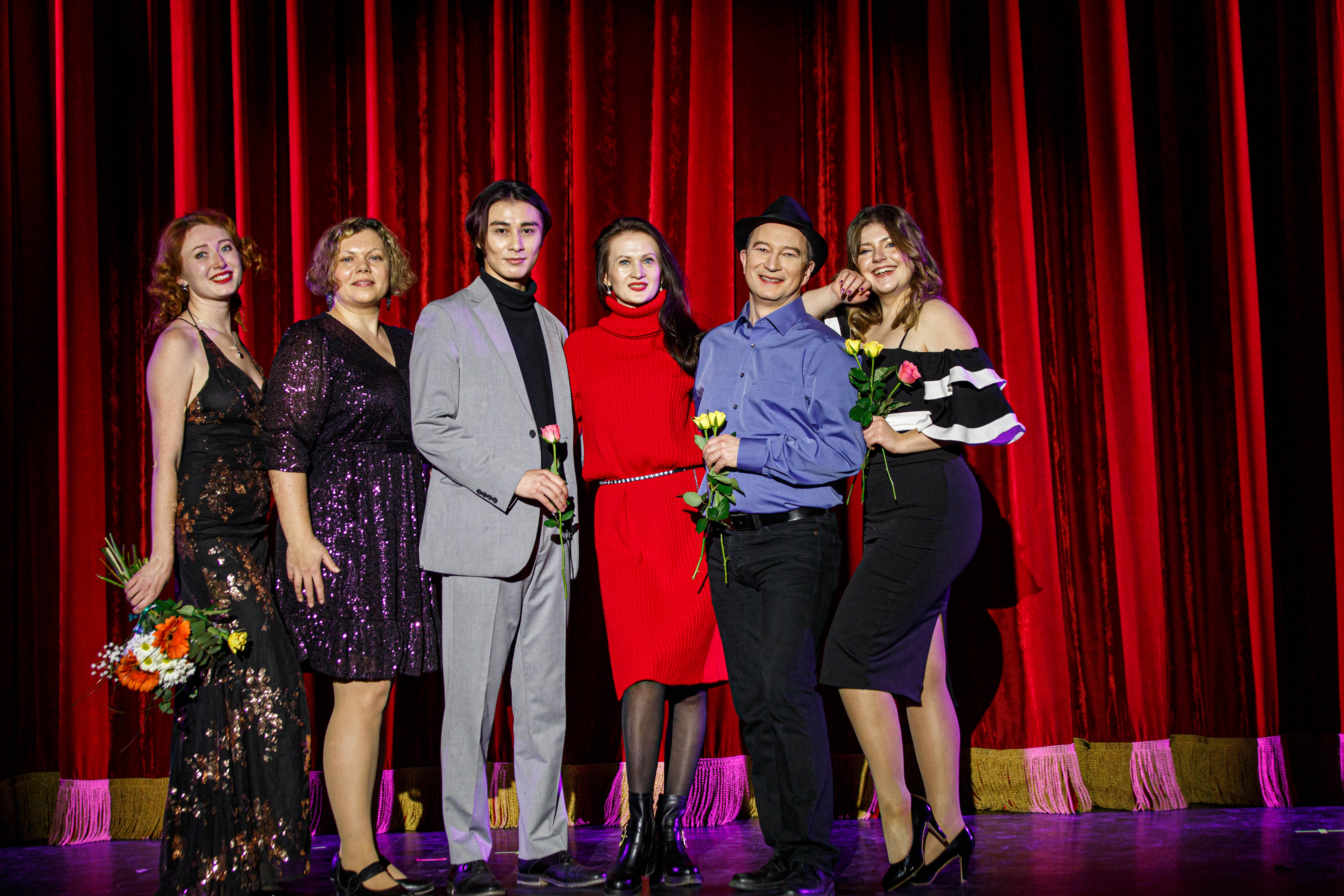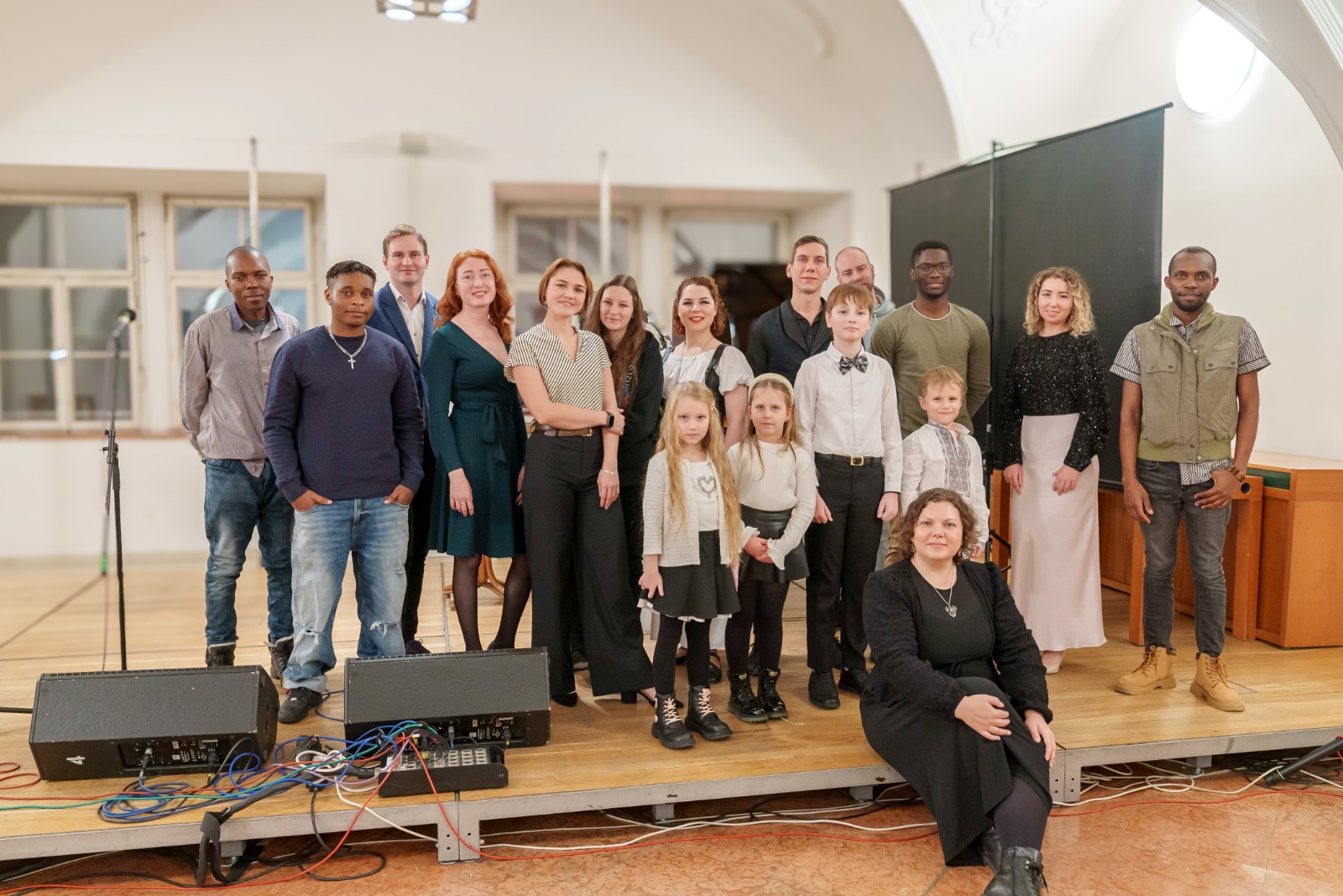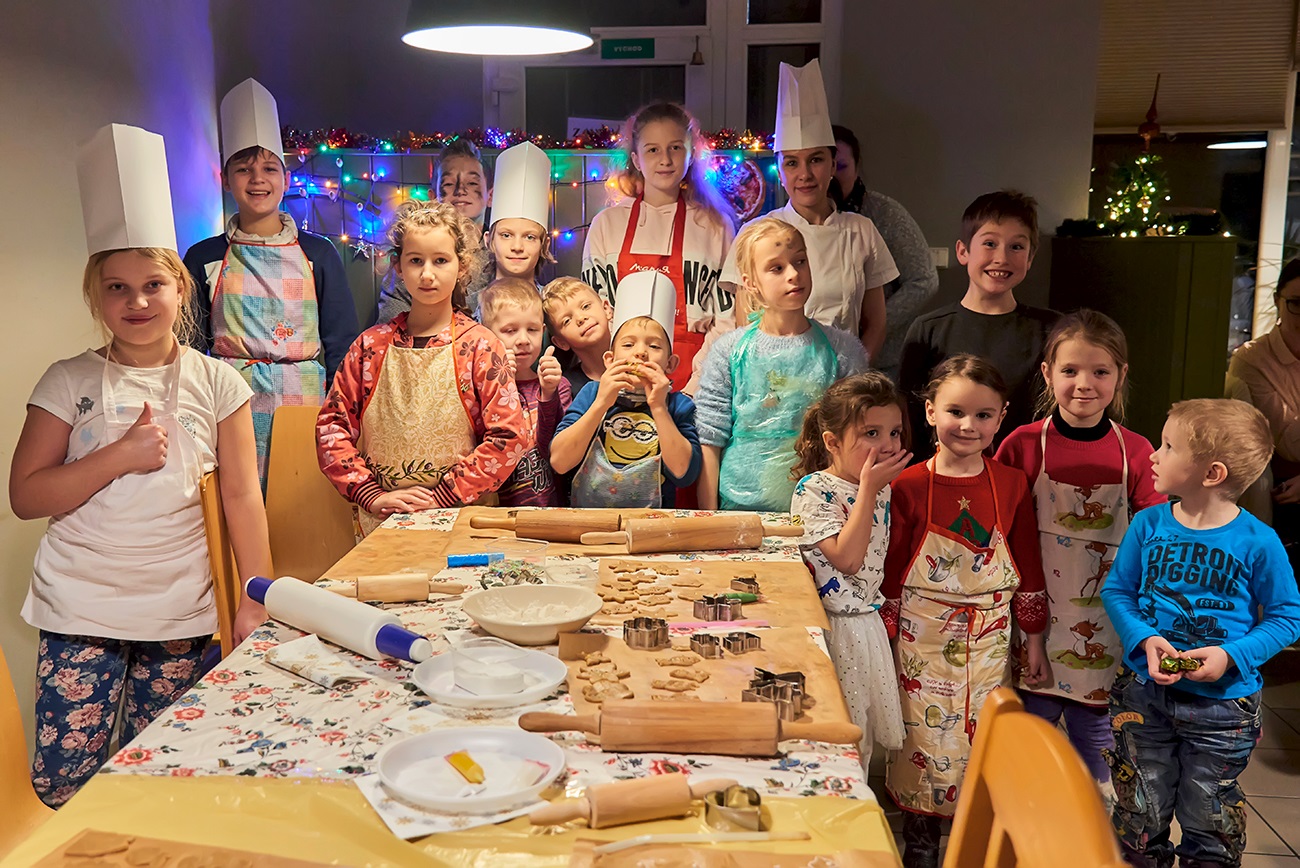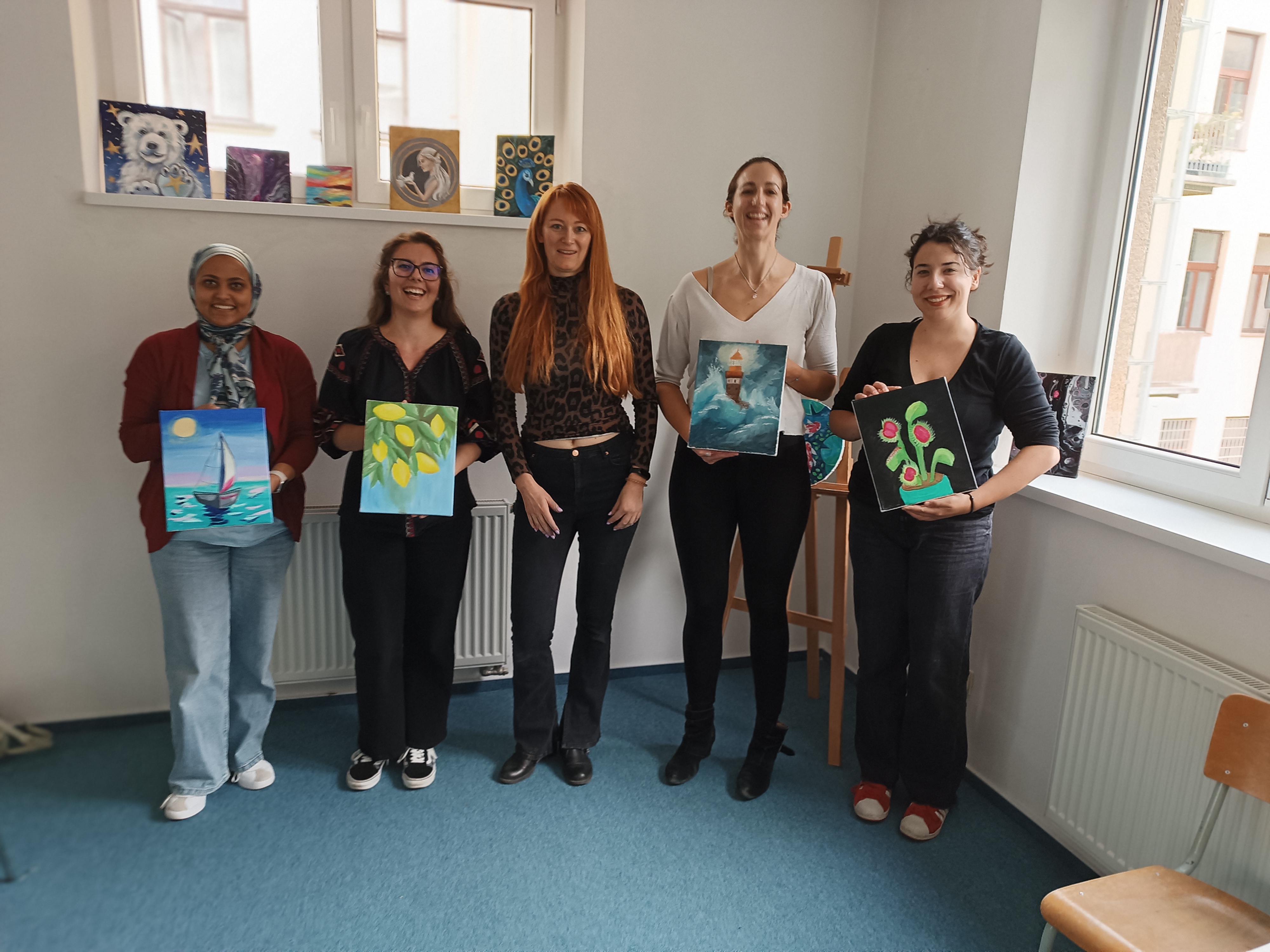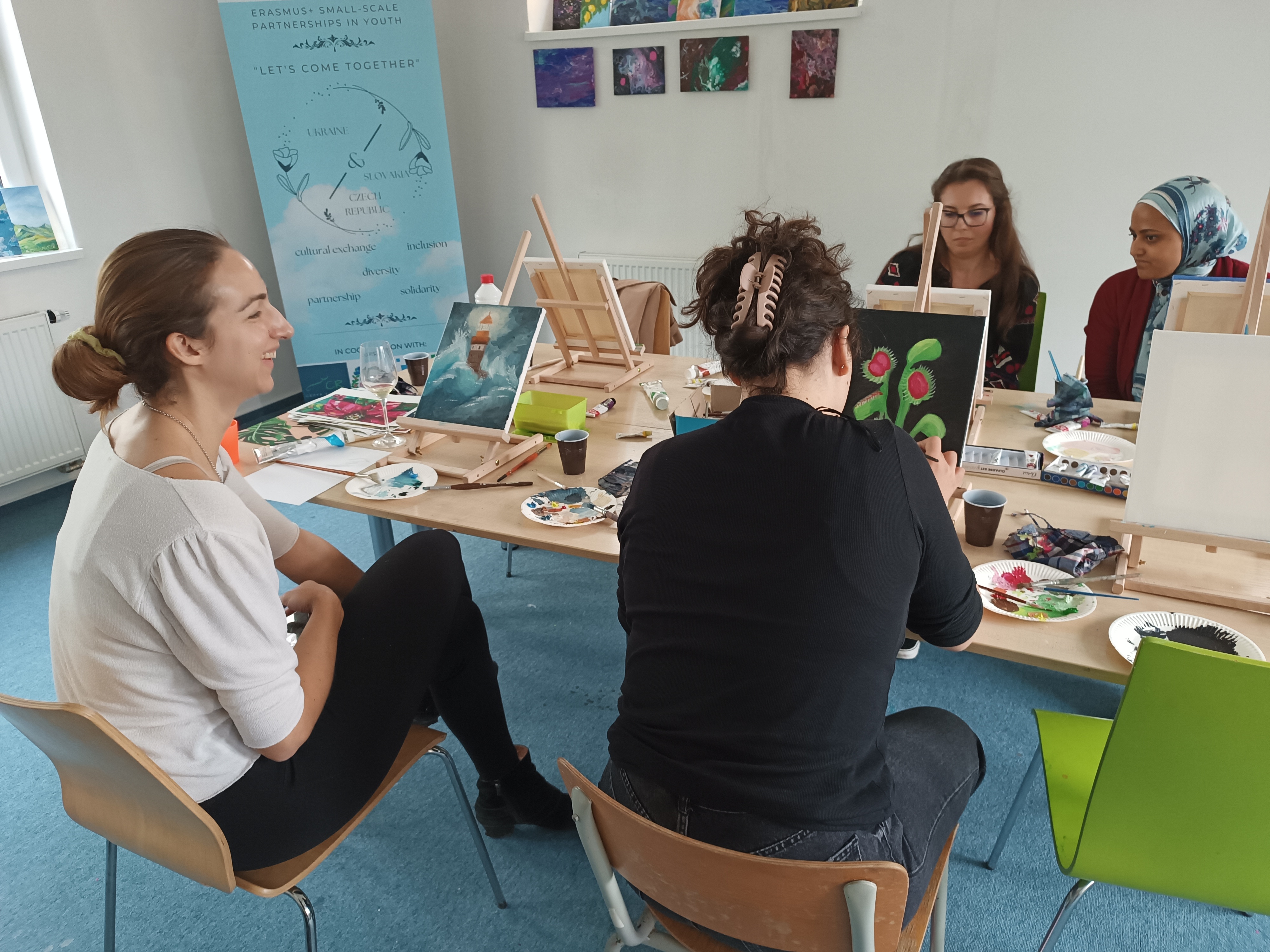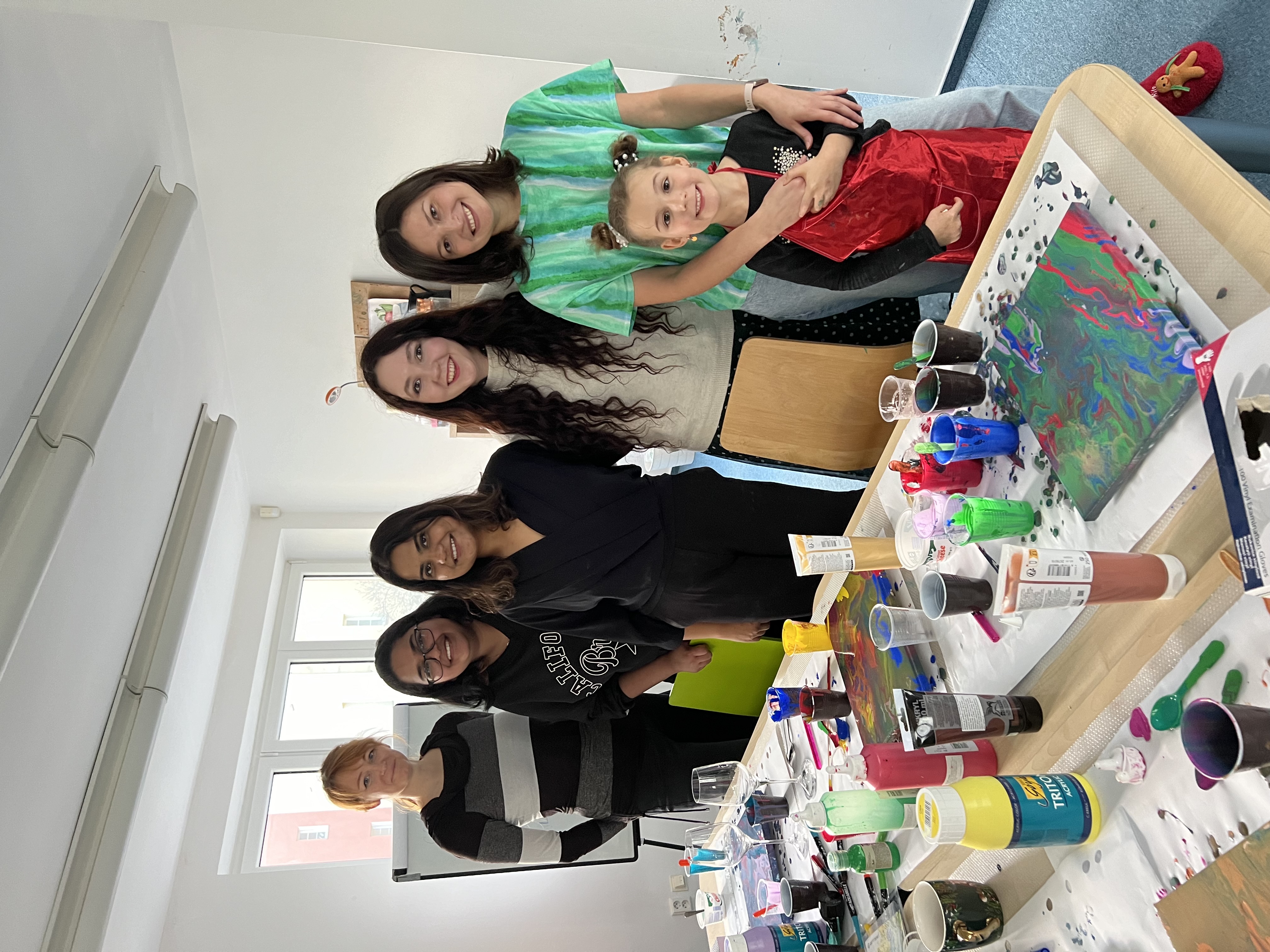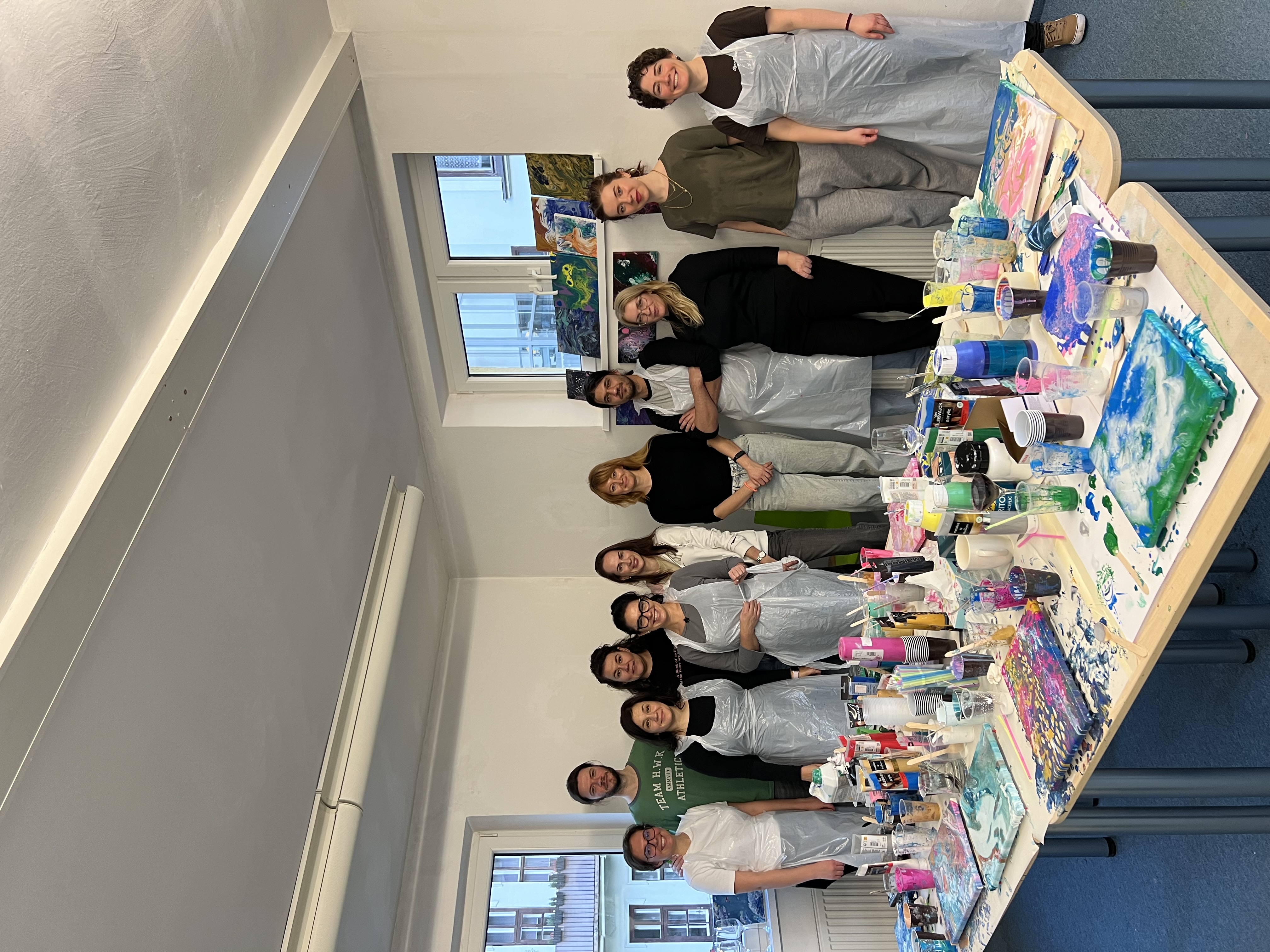Regaining a sense of belonging
Roots & Wings
Roots & Wings: Transforming Spaces for Belonging & Well-being
Roots & Wings is a creative initiative in Brno that nurtures belonging through art, language, self-development, co-creation and wellbeing. By transforming our space into a vibrant hub of connection, we empower diverse communities to express themselves, heal and grow together. Through coaching, art therapy, rhetoric and immersive creative workshops, we cultivate an environment where everyone can take root in a supportive community and spread their wings with confidence.
Czechia
Local
Brno
It addresses urban-rural linkages
It refers to other types of transformations (soft investment)
Yes
2024-12-31
Yes
ERASMUS
No
Yes
No
Yes
As a representative of an organisation
Roots & Wings is a creative initiative in Brno that transforms spaces into vibrant hubs of belonging, connection and personal growth. Through art, language, self-development and wellbeing, we empower diverse communities to express themselves, heal and build meaningful relationships. By integrating coaching, art therapy, storytelling and immersive creative workshops, we cultivate an inclusive environment where individuals can take root in a supportive community and confidently spread their wings.
Target Groups
- Migrants and refugees
- Ethnic minorities
- People facing social exclusion
- Local residents seeking intercultural dialogue
Specific Objectives
- Redesign and repurpose community spaces to foster belonging, creativity and social interaction
- Provide expressive and therapeutic programs that enhance mental wellbeing and resilience
- Strengthen intercultural communication through language, storytelling and artistic collaboration
- Encourage active community participation in co-creating inclusive and welcoming spaces
Achieved Outcomes
- Successfully transformed public spaces into dynamic cultural and creative hubs
- Engaged over 500 participants in art therapy, coaching and language-based workshops
- Fostered intercultural dialogue and strengthened social networks within local communities
- Developed a sustainable model for inclusive space transformation through art and co-creation
Through Roots & Wings, we demonstrate how creative interventions can foster belonging, empower marginalized groups and nurture communities where everyone can grow, connect and thrive.
Target Groups
- Migrants and refugees
- Ethnic minorities
- People facing social exclusion
- Local residents seeking intercultural dialogue
Specific Objectives
- Redesign and repurpose community spaces to foster belonging, creativity and social interaction
- Provide expressive and therapeutic programs that enhance mental wellbeing and resilience
- Strengthen intercultural communication through language, storytelling and artistic collaboration
- Encourage active community participation in co-creating inclusive and welcoming spaces
Achieved Outcomes
- Successfully transformed public spaces into dynamic cultural and creative hubs
- Engaged over 500 participants in art therapy, coaching and language-based workshops
- Fostered intercultural dialogue and strengthened social networks within local communities
- Developed a sustainable model for inclusive space transformation through art and co-creation
Through Roots & Wings, we demonstrate how creative interventions can foster belonging, empower marginalized groups and nurture communities where everyone can grow, connect and thrive.
Inclusion
Sustainability
Creativity
Wellbeing
Community
Objectives
Repurposing public spaces instead of building new ones to reduce environmental impact
Using eco-friendly materials and promoting recycling in creative workshops and installations
Raising awareness of sustainable practices through community engagement and art-based education
Establishing long-term spaces that continue benefiting the community and environment beyond the project’s duration
By merging sustainability inclusivity and aesthetics Roots & Wings creates a lasting impact demonstrating how creative interventions can transform cities and empower communities in alignment with the New European Bauhaus vision.
Repurposing public spaces instead of building new ones to reduce environmental impact
Using eco-friendly materials and promoting recycling in creative workshops and installations
Raising awareness of sustainable practices through community engagement and art-based education
Establishing long-term spaces that continue benefiting the community and environment beyond the project’s duration
By merging sustainability inclusivity and aesthetics Roots & Wings creates a lasting impact demonstrating how creative interventions can transform cities and empower communities in alignment with the New European Bauhaus vision.
The Roots & Wings project aimed to create aesthetically engaging, inclusive and culturally rich spaces that enhance community wellbeing and quality of experience. By combining art, design, storytelling and cultural programming, the project transformed public spaces into vibrant hubs of interaction, creativity and self-expression.
Aesthetically, the project prioritized co-creation with local residents, migrants and ethnic minorities, ensuring that the spaces reflected diverse cultural identities. Through collaborative mural painting, installations and participatory urban design, the project enhanced public spaces visually while fostering a sense of belonging. Art therapy and creative workshops allowed participants to contribute to their environment, making the design process deeply personal and emotionally meaningful.
In terms of quality of experience, the project provided accessible spaces where people could engage in coaching, art therapy, wellbeing sessions and public speaking courses. These activities not only empowered individuals but also activated public spaces in a way that encouraged interaction, learning and cultural exchange. By integrating mental health support with artistic expression, the project created an innovative model where people could heal, grow and connect.
This approach serves as an exemplary model by demonstrating how aesthetic quality and cultural engagement can drive social inclusion. By blending participatory art, community-led design and personal development programs, Roots & Wings showcases how cities can use culture and creativity to strengthen community ties, improve public wellbeing and inspire similar projects globally.
Aesthetically, the project prioritized co-creation with local residents, migrants and ethnic minorities, ensuring that the spaces reflected diverse cultural identities. Through collaborative mural painting, installations and participatory urban design, the project enhanced public spaces visually while fostering a sense of belonging. Art therapy and creative workshops allowed participants to contribute to their environment, making the design process deeply personal and emotionally meaningful.
In terms of quality of experience, the project provided accessible spaces where people could engage in coaching, art therapy, wellbeing sessions and public speaking courses. These activities not only empowered individuals but also activated public spaces in a way that encouraged interaction, learning and cultural exchange. By integrating mental health support with artistic expression, the project created an innovative model where people could heal, grow and connect.
This approach serves as an exemplary model by demonstrating how aesthetic quality and cultural engagement can drive social inclusion. By blending participatory art, community-led design and personal development programs, Roots & Wings showcases how cities can use culture and creativity to strengthen community ties, improve public wellbeing and inspire similar projects globally.
The project was designed with inclusion at its core, aiming to create spaces that are accessible, affordable and welcoming to everyone, regardless of background, ability or social status. One of the key objectives was to foster community cohesion by involving diverse groups, including refugees, migrants and ethnic minorities, in the co-creation of public spaces. This participatory approach ensured that the design reflected the needs and desires of the community, giving everyone a sense of ownership and belonging.
The project’s design was rooted in universal accessibility principles, ensuring that spaces were physically, socially and culturally inclusive. Public spaces were tailored to accommodate people with different abilities, including those with mobility issues, by integrating accessible pathways, seating and facilities. In terms of affordability, the project was free and open to all community members, with no barriers to entry for participation in activities such as workshops, coaching or art therapy.
The project also embraced inclusive governance systems, involving local residents and community members in decision-making processes. This approach empowered marginalized groups by giving them a voice in the planning and implementation of activities, fostering a sense of shared responsibility and engagement. Moreover, the focus on art therapy, mental health support and coaching addressed the specific needs of individuals from disadvantaged backgrounds, creating an environment where personal growth and healing were accessible to all. By blending these elements, the project created a new societal model of inclusive, community-driven spaces that encourage collaboration, diversity and empowerment. It serves as an exemplary initiative for how inclusive design principles can be applied to public space transformation, offering a scalable model that can be replicated in other regions.
The project’s design was rooted in universal accessibility principles, ensuring that spaces were physically, socially and culturally inclusive. Public spaces were tailored to accommodate people with different abilities, including those with mobility issues, by integrating accessible pathways, seating and facilities. In terms of affordability, the project was free and open to all community members, with no barriers to entry for participation in activities such as workshops, coaching or art therapy.
The project also embraced inclusive governance systems, involving local residents and community members in decision-making processes. This approach empowered marginalized groups by giving them a voice in the planning and implementation of activities, fostering a sense of shared responsibility and engagement. Moreover, the focus on art therapy, mental health support and coaching addressed the specific needs of individuals from disadvantaged backgrounds, creating an environment where personal growth and healing were accessible to all. By blending these elements, the project created a new societal model of inclusive, community-driven spaces that encourage collaboration, diversity and empowerment. It serves as an exemplary initiative for how inclusive design principles can be applied to public space transformation, offering a scalable model that can be replicated in other regions.
Citizens benefiting from the Roots & Wings project, including local residents, migrants, ethnic minorities and civil society groups, have played a central role in the project’s development and success. Their active involvement, from the early stages to the final implementation, has been crucial to ensure the project meets the diverse needs of the community.
During the design phase, citizens were invited to join co-design workshops, public consultations and community meetings. These sessions gave people the opportunity to share ideas, express concerns and suggest improvements. This helped shape the project’s public spaces, making them accessible, welcoming and tailored to local needs. Their input played a major role in shaping the overall design and functionality of the spaces, such as the layout and the types of activities offered. This process gave the community a sense of ownership and made them feel involved in the project’s success.
During implementation, local residents, migrants and civil society organizations contributed to organizing and leading activities like workshops, art therapy sessions, coaching and public speaking courses. Their participation ensured these programs were relevant and culturally appropriate for everyone. They also supported initiatives related to mental health and wellbeing, helping people address challenges like emotional trauma or social isolation in a safe environment.
This involvement had a significant impact. By including citizens in the decision-making and execution processes, the project built a sense of community and encouraged people to take collective responsibility. It improved the mental and emotional wellbeing of participants, who felt heard, valued and empowered. This involvement helped create a more inclusive, resilient and connected community, improving the overall quality of life for everyone involved.
During the design phase, citizens were invited to join co-design workshops, public consultations and community meetings. These sessions gave people the opportunity to share ideas, express concerns and suggest improvements. This helped shape the project’s public spaces, making them accessible, welcoming and tailored to local needs. Their input played a major role in shaping the overall design and functionality of the spaces, such as the layout and the types of activities offered. This process gave the community a sense of ownership and made them feel involved in the project’s success.
During implementation, local residents, migrants and civil society organizations contributed to organizing and leading activities like workshops, art therapy sessions, coaching and public speaking courses. Their participation ensured these programs were relevant and culturally appropriate for everyone. They also supported initiatives related to mental health and wellbeing, helping people address challenges like emotional trauma or social isolation in a safe environment.
This involvement had a significant impact. By including citizens in the decision-making and execution processes, the project built a sense of community and encouraged people to take collective responsibility. It improved the mental and emotional wellbeing of participants, who felt heard, valued and empowered. This involvement helped create a more inclusive, resilient and connected community, improving the overall quality of life for everyone involved.
The Roots & Wings project engaged stakeholders at local, regional, national and European levels, ensuring a broad and inclusive approach.
At the local level, residents, migrants, ethnic minorities and civil society groups were actively involved in co-designing public spaces through workshops, consultations and community meetings. Their input directly shaped the design and programming, ensuring the project was relevant and accessible to all. This involvement fostered a sense of ownership and empowered the community.
At the regional level, local authorities and cultural institutions contributed resources, expertise and funding. They ensured the project aligned with broader regional development goals, such as social inclusion and urban regeneration, amplifying the project’s impact.
At the national level, partnerships with government bodies and cultural organizations provided strategic guidance and ensured the project adhered to national policies on inclusion and sustainability. Their support helped secure funding and visibility.
At the European level, connections with European institutions, including the New European Bauhaus initiative, facilitated knowledge exchange and alignment with EU priorities. Their involvement brought access to funding opportunities and broadened the project’s impact.
The engagement of stakeholders at all levels enhanced the project’s relevance, sustainability and scalability, ensuring lasting, positive change for the community.
At the local level, residents, migrants, ethnic minorities and civil society groups were actively involved in co-designing public spaces through workshops, consultations and community meetings. Their input directly shaped the design and programming, ensuring the project was relevant and accessible to all. This involvement fostered a sense of ownership and empowered the community.
At the regional level, local authorities and cultural institutions contributed resources, expertise and funding. They ensured the project aligned with broader regional development goals, such as social inclusion and urban regeneration, amplifying the project’s impact.
At the national level, partnerships with government bodies and cultural organizations provided strategic guidance and ensured the project adhered to national policies on inclusion and sustainability. Their support helped secure funding and visibility.
At the European level, connections with European institutions, including the New European Bauhaus initiative, facilitated knowledge exchange and alignment with EU priorities. Their involvement brought access to funding opportunities and broadened the project’s impact.
The engagement of stakeholders at all levels enhanced the project’s relevance, sustainability and scalability, ensuring lasting, positive change for the community.
The Roots & Wings project is a rich intersection of diverse disciplines, combining urban design, mental health, art therapy, community development and sociology. These fields worked together to create an inclusive, holistic approach that addresses both physical and emotional needs within the community.
Urban designers collaborated with community development experts to transform public spaces into accessible, welcoming environments, ensuring functionality and aesthetic appeal for diverse users. Mental health professionals and art therapists contributed to the design of safe spaces for emotional healing, using creative expression as a therapeutic tool to address trauma and isolation. Sociologists provided valuable insights into the dynamics of the community, helping to shape participatory processes that fostered a sense of belonging and social integration.
The collaborative approach ensured that each discipline’s expertise complemented the others, creating a seamless experience for beneficiaries. Urban planners made spaces physically welcoming, while therapists provided emotional support and sociologists ensured inclusivity in design. This multi-disciplinary synergy enriched the project, offering solutions that were not only innovative but deeply responsive to the community’s needs.
The added value of this process was in the interdisciplinary dialogue, which led to creative, sustainable solutions that addressed the complexities of urban life, mental health and social cohesion. This integrated approach maximized impact and ensured that the project’s outcomes were both practical and transformative for the community.
Urban designers collaborated with community development experts to transform public spaces into accessible, welcoming environments, ensuring functionality and aesthetic appeal for diverse users. Mental health professionals and art therapists contributed to the design of safe spaces for emotional healing, using creative expression as a therapeutic tool to address trauma and isolation. Sociologists provided valuable insights into the dynamics of the community, helping to shape participatory processes that fostered a sense of belonging and social integration.
The collaborative approach ensured that each discipline’s expertise complemented the others, creating a seamless experience for beneficiaries. Urban planners made spaces physically welcoming, while therapists provided emotional support and sociologists ensured inclusivity in design. This multi-disciplinary synergy enriched the project, offering solutions that were not only innovative but deeply responsive to the community’s needs.
The added value of this process was in the interdisciplinary dialogue, which led to creative, sustainable solutions that addressed the complexities of urban life, mental health and social cohesion. This integrated approach maximized impact and ensured that the project’s outcomes were both practical and transformative for the community.
The Roots & Wings project stands out for its innovative approach by seamlessly integrating mental health, art therapy, community development and urban regeneration into a single transformative initiative. Unlike mainstream projects that often focus on one aspect, such as physical infrastructure or social programs, this project holistically addresses both the emotional and social wellbeing of marginalized groups while reshaping public spaces.
One of the key innovations is the use of art therapy and coaching in community-driven public space design. By offering therapeutic workshops in creative expression alongside coaching and mental health support, the project enables individuals to heal, connect and empower themselves, fostering resilience and personal growth within the community. This is a far cry from traditional urban regeneration efforts that usually prioritize aesthetics or functionality over emotional wellbeing and personal empowerment.
Another innovative dimension is the co-creation model, where community members, including refugees, migrants and minorities, are actively involved in the design of the spaces they will use. This participatory approach ensures that public spaces are not just designed for people but with people, reflecting their cultural needs, aspirations and identities.
Moreover, the integration of wellbeing programs into urban development is rarely seen in mainstream practices. By addressing mental health issues, trauma and isolation within the physical environment, the project promotes long-term, sustainable community cohesion and social inclusion.
Overall, Roots & Wings offers a pioneering, interdisciplinary model that merges urban planning, mental health, community participation and cultural integration, setting a new standard for projects that aim to transform both public spaces and the lives of those who inhabit them.
One of the key innovations is the use of art therapy and coaching in community-driven public space design. By offering therapeutic workshops in creative expression alongside coaching and mental health support, the project enables individuals to heal, connect and empower themselves, fostering resilience and personal growth within the community. This is a far cry from traditional urban regeneration efforts that usually prioritize aesthetics or functionality over emotional wellbeing and personal empowerment.
Another innovative dimension is the co-creation model, where community members, including refugees, migrants and minorities, are actively involved in the design of the spaces they will use. This participatory approach ensures that public spaces are not just designed for people but with people, reflecting their cultural needs, aspirations and identities.
Moreover, the integration of wellbeing programs into urban development is rarely seen in mainstream practices. By addressing mental health issues, trauma and isolation within the physical environment, the project promotes long-term, sustainable community cohesion and social inclusion.
Overall, Roots & Wings offers a pioneering, interdisciplinary model that merges urban planning, mental health, community participation and cultural integration, setting a new standard for projects that aim to transform both public spaces and the lives of those who inhabit them.
The Roots & Wings project follows a participatory and holistic methodology that integrates urban transformation, community engagement, mental health support and cultural diversity for maximum impact. The first key element is co-design, where local residents, migrants, ethnic minorities and marginalized groups actively shape public spaces. This participatory process ensures spaces meet diverse community needs, fostering ownership and belonging. Workshops, consultations and co-creation sessions gather input on design, accessibility and functionality, ensuring inclusivity at every stage.
The project also incorporates art therapy and coaching, blending creative expression with mental health support. This approach addresses the emotional needs of vulnerable groups, enabling them to heal and connect. Through art therapy, coaching and creative workshops, participants improve their wellbeing and resilience, which is vital for social inclusion and cohesion.
In terms of cultural diversity, the project transforms public spaces into platforms for intercultural dialogue and artistic exchange, allowing diverse communities to share their heritage, celebrate diversity and learn from each other. This strengthens social cohesion and bridges cultural divides.
Finally, sustainability is prioritized by ensuring that transformed spaces remain functional and inclusive long-term. The project combines art, public space design and cultural programming to create lasting community impact.
By integrating design thinking, participatory engagement and social impact, Roots & Wings offers an innovative and sustainable model to address the needs of marginalized communities.
The project also incorporates art therapy and coaching, blending creative expression with mental health support. This approach addresses the emotional needs of vulnerable groups, enabling them to heal and connect. Through art therapy, coaching and creative workshops, participants improve their wellbeing and resilience, which is vital for social inclusion and cohesion.
In terms of cultural diversity, the project transforms public spaces into platforms for intercultural dialogue and artistic exchange, allowing diverse communities to share their heritage, celebrate diversity and learn from each other. This strengthens social cohesion and bridges cultural divides.
Finally, sustainability is prioritized by ensuring that transformed spaces remain functional and inclusive long-term. The project combines art, public space design and cultural programming to create lasting community impact.
By integrating design thinking, participatory engagement and social impact, Roots & Wings offers an innovative and sustainable model to address the needs of marginalized communities.
The project offers high potential for transferability and replicability due to its adaptable methodology, inclusive processes and focus on community-driven transformation. Key elements of the project can be applied in different contexts and for various beneficiary groups.
1. Participatory Co-Design Process: this approach, where local communities, including migrants and marginalized groups, actively participate in shaping public spaces, is easily replicable. The process involving workshops and consultations can be applied globally to ensure inclusivity in urban transformation.
2. Art Therapy & Coaching: the integration of art therapy and coaching for mental health support can be adapted to other communities facing social exclusion. This helps individuals heal, express themselves and build resilience. By offering art therapy and creative workshops the project supports wellbeing and social cohesion, making it suitable for different cultural contexts.
3. Cultural Diversity & Intercultural Dialogue: focus on cultural diversity and intercultural dialogue can be replicated in cities with diverse populations. This can be tailored to other regions to foster inclusion and strengthen social ties.
4. Sustainable Urban Transformation: the sustainable urban transformation model, repurposing existing spaces with eco-friendly materials, can be applied to other urban areas. By revitalizing underused spaces, the project creates vibrant community hubs that prioritize environmental sustainability, offering a scalable solution for urban regeneration worldwide.
5. Community-Driven Cultural Programming: cultural activities that foster local engagement can be replicated in different regions. These programs encourage creativity, connection and a sense of belonging, making them adaptable to local needs and contributing to social sustainability.
6. The project’s insights into effective community engagement, mental health integration, sustainable design can be shared globally.
1. Participatory Co-Design Process: this approach, where local communities, including migrants and marginalized groups, actively participate in shaping public spaces, is easily replicable. The process involving workshops and consultations can be applied globally to ensure inclusivity in urban transformation.
2. Art Therapy & Coaching: the integration of art therapy and coaching for mental health support can be adapted to other communities facing social exclusion. This helps individuals heal, express themselves and build resilience. By offering art therapy and creative workshops the project supports wellbeing and social cohesion, making it suitable for different cultural contexts.
3. Cultural Diversity & Intercultural Dialogue: focus on cultural diversity and intercultural dialogue can be replicated in cities with diverse populations. This can be tailored to other regions to foster inclusion and strengthen social ties.
4. Sustainable Urban Transformation: the sustainable urban transformation model, repurposing existing spaces with eco-friendly materials, can be applied to other urban areas. By revitalizing underused spaces, the project creates vibrant community hubs that prioritize environmental sustainability, offering a scalable solution for urban regeneration worldwide.
5. Community-Driven Cultural Programming: cultural activities that foster local engagement can be replicated in different regions. These programs encourage creativity, connection and a sense of belonging, making them adaptable to local needs and contributing to social sustainability.
6. The project’s insights into effective community engagement, mental health integration, sustainable design can be shared globally.
The Roots & Wings project addresses global challenges by providing local solutions to critical issues such as social fragmentation, fear of integration and unsustainable development.
Social Fragmentation & Isolation
Globally, rapid migration and urbanization often lead to social isolation and fragmentation of communities, creating divides between locals and newcomers. This isolation fosters mistrust, fear and a lack of social cohesion. By transforming public spaces into inclusive hubs, the project combats these issues, creating safe spaces for interaction and understanding. It fosters community resilience, turning physical spaces into platforms for connection, dialogue and healing, essential for building strong, cohesive communities.
Fear of Integration & Cultural Barriers
As migration increases worldwide, many refugees and migrants face fear of integration due to language barriers, cultural differences and social exclusion. This fear can deepen divisions and prevent full participation in society. Roots & Wings offers local solutions by promoting intercultural dialogue and artistic exchange. Through creative workshops and language support, the project encourages integration, reduces prejudice and fosters mutual understanding among diverse groups.
Unsustainable Development
Globally, many urban areas face unsustainable urbanization, leading to environmental degradation and underutilized public spaces. Roots & Wings addresses this by repurposing existing infrastructure, minimizing environmental impact while creating spaces that are both sustainable and functional. The use of eco-friendly materials and upcycling promotes environmentally conscious practices, aligning with the global need for sustainable urban development.
In addressing these interconnected global challenges, the Roots & Wings project provides practical, scalable solutions that can be replicated in other regions, contributing to more inclusive, resilient and sustainable communities.
Social Fragmentation & Isolation
Globally, rapid migration and urbanization often lead to social isolation and fragmentation of communities, creating divides between locals and newcomers. This isolation fosters mistrust, fear and a lack of social cohesion. By transforming public spaces into inclusive hubs, the project combats these issues, creating safe spaces for interaction and understanding. It fosters community resilience, turning physical spaces into platforms for connection, dialogue and healing, essential for building strong, cohesive communities.
Fear of Integration & Cultural Barriers
As migration increases worldwide, many refugees and migrants face fear of integration due to language barriers, cultural differences and social exclusion. This fear can deepen divisions and prevent full participation in society. Roots & Wings offers local solutions by promoting intercultural dialogue and artistic exchange. Through creative workshops and language support, the project encourages integration, reduces prejudice and fosters mutual understanding among diverse groups.
Unsustainable Development
Globally, many urban areas face unsustainable urbanization, leading to environmental degradation and underutilized public spaces. Roots & Wings addresses this by repurposing existing infrastructure, minimizing environmental impact while creating spaces that are both sustainable and functional. The use of eco-friendly materials and upcycling promotes environmentally conscious practices, aligning with the global need for sustainable urban development.
In addressing these interconnected global challenges, the Roots & Wings project provides practical, scalable solutions that can be replicated in other regions, contributing to more inclusive, resilient and sustainable communities.
The project has achieved significant results in social inclusion, community engagement, mental wellbeing and sustainable urban development, impacting both direct and indirect beneficiaries.
Results & Outcomes
Social Inclusion & Community Cohesion
The project transformed underutilized public spaces into inclusive hubs for diverse communities, fostering social cohesion. Over 500 participants, including migrants, refugees, ethnic minorities and local residents, engaged in co-design sessions, workshops and cultural activities. These spaces became places for connection, building mutual understanding and reducing social fragmentation.
Mental Well-Being & Healing
Art therapy and creative workshops significantly improved participants' emotional health. Many individuals, especially from marginalized backgrounds, reported feeling empowered and more resilient, with enhanced self-expression and support in coping with trauma and stress.
Increased Intercultural Dialogue
The project encouraged intercultural exchange through cultural expressions and dialogues. It helped reduce stereotypes, promote cultural appreciation and create a sense of belonging, making the community more inclusive and understanding.
Sustainable Urban Transformation
By repurposing public spaces instead of constructing new infrastructure, the project contributed to environmental sustainability. Using recycled materials and upcycling minimized waste and created functional, long-term community spaces that support sustainability.
Impacts on Beneficiaries
Direct Beneficiaries: Migrants, refugees, ethnic minorities and locals benefited from self-expression, language learning and community building, leading to increased confidence and social integration. Mental health support also improved their well-being.
Indirect Beneficiaries: Local residents and city planners benefited from enhanced public spaces, which promote social cohesion and offer a model for sustainable urban development.
Results & Outcomes
Social Inclusion & Community Cohesion
The project transformed underutilized public spaces into inclusive hubs for diverse communities, fostering social cohesion. Over 500 participants, including migrants, refugees, ethnic minorities and local residents, engaged in co-design sessions, workshops and cultural activities. These spaces became places for connection, building mutual understanding and reducing social fragmentation.
Mental Well-Being & Healing
Art therapy and creative workshops significantly improved participants' emotional health. Many individuals, especially from marginalized backgrounds, reported feeling empowered and more resilient, with enhanced self-expression and support in coping with trauma and stress.
Increased Intercultural Dialogue
The project encouraged intercultural exchange through cultural expressions and dialogues. It helped reduce stereotypes, promote cultural appreciation and create a sense of belonging, making the community more inclusive and understanding.
Sustainable Urban Transformation
By repurposing public spaces instead of constructing new infrastructure, the project contributed to environmental sustainability. Using recycled materials and upcycling minimized waste and created functional, long-term community spaces that support sustainability.
Impacts on Beneficiaries
Direct Beneficiaries: Migrants, refugees, ethnic minorities and locals benefited from self-expression, language learning and community building, leading to increased confidence and social integration. Mental health support also improved their well-being.
Indirect Beneficiaries: Local residents and city planners benefited from enhanced public spaces, which promote social cohesion and offer a model for sustainable urban development.

